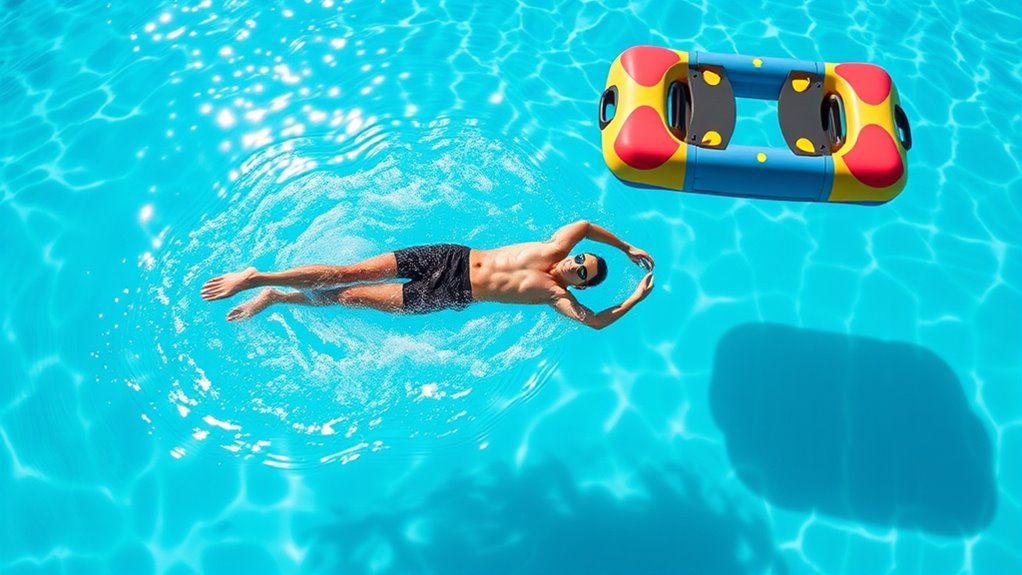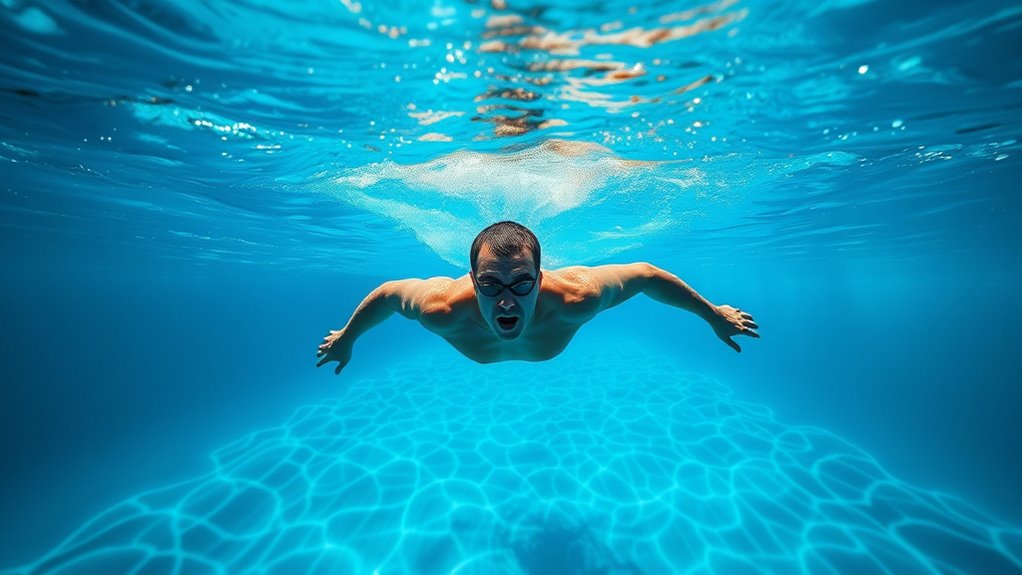Incorporating float and swim intervals into your practice can boost your endurance by challenging your body to maintain rhythmic, relaxed movements while focusing on proper breathing techniques. Using tools like kickboards, pull buoys, and fins targets key muscle groups, helping you improve technique and efficiency. Start with warm-ups, set clear goals, and gradually increase effort and reduce rest over time. Stay consistent, and you’ll see steady progress—keep exploring to discover even more ways to enhance your stamina.
Key Takeaways
- Incorporate float drills within swim intervals to improve breathing control and relaxation, enhancing endurance.
- Use flotation equipment like pull buoys to focus on efficient stroke technique during intervals.
- Structure intervals with progressive intensity and reduced rest to build cardiovascular stamina.
- Focus on rhythmic breathing during floats and swims to sustain energy over longer sessions.
- Regularly combine float and swim intervals to develop consistent pacing and muscular endurance over time.

If you’re looking to improve your swimming endurance and efficiency, incorporating float and swim intervals into your workout can be highly effective. These intervals challenge your body to maintain a steady rhythm, helping you build stamina over time. One of the most vital aspects to focus on during these sessions is your breathing techniques. Proper breathing not only supplies your muscles with oxygen but also prevents fatigue and encourages a relaxed, efficient swim. Practice rhythmic breathing, inhaling deeply through your mouth or nose, turning your head smoothly during each stroke. This minimizes unnecessary arm and head movements, conserving energy. As you get comfortable with breathing techniques, you’ll find yourself able to swim longer without feeling winded. Additionally, understanding the science behind at‑home swim training can help you optimize your workouts and track progress more effectively. Pool equipment can play an essential role in optimizing your float and swim intervals. Using tools like kickboards, pull buoys, or fins can target specific muscle groups, improve technique, and increase your endurance. For example, a kickboard allows you to focus solely on your kicking technique, which helps strengthen your legs and improve propulsion. A pull buoy keeps your lower body afloat, shifting your focus to arm movement and breathing, enhancing your overall efficiency. Fins can increase your speed and build leg strength, making your strokes more powerful and sustainable. Incorporating these pieces of equipment strategically into your intervals can make your workouts more effective and tailored to your needs. During your sessions, start with a warm-up to loosen your muscles and prepare your body. Then, set specific interval goals, such as swimming for a certain distance or time, followed by a brief rest. For example, swim 100 meters at a steady pace, then rest for 20-30 seconds before repeating. As you progress, increase the intensity or duration of your swim segments and reduce your rest periods gradually. This approach pushes your cardiovascular system and muscular endurance, gradually increasing your capacity. Remember to stay focused on your breathing throughout each interval, maintaining a relaxed, steady rhythm that keeps you from gasping or holding your breath. Consistency is key. Incorporate float and swim intervals into your regular training schedule, and you’ll notice improvements in both endurance and technique. Use pool equipment to challenge yourself and refine your skills, making each workout more engaging and productive. Over time, you’ll find yourself swimming longer distances with less fatigue, and your overall efficiency in the water will markedly improve. Keep practicing your breathing techniques, utilize the right equipment, and stay committed to your intervals, and you’ll see the results you’re aiming for.
Frequently Asked Questions
How Often Should I Incorporate Float + Swim Intervals Into My Training?
You should incorporate float + swim intervals into your training 1 to 2 times a week. This frequency allows you to build endurance without overtraining, helping prevent injuries. By mixing these intervals into your routine regularly, you’ll improve your stamina and technique. Remember, consistency is key, but listen to your body—if you feel fatigued, give yourself extra rest days to avoid injury and maximize your training benefits.
Can Float + Swim Intervals Improve Open Water Swimming Skills?
Yes, float + swim intervals can improve your open water swimming skills by enhancing your breathing control, sharpening your mental focus, and building your confidence. These intervals train you to stay calm and steady amid unpredictable conditions, helping you adapt better to currents and waves. By practicing controlled breathing and maintaining mental clarity during these sessions, you develop the skills needed to navigate open water more effectively and efficiently.
Are Float + Swim Intervals Suitable for Beginner Swimmers?
Yes, float + swim intervals are suitable for beginner swimmers. They help you focus on improving your breaststroke technique while maintaining proper swim pace control. By incorporating floating, you build confidence and body awareness, making it easier to stay relaxed in the water. These intervals allow you to practice at a gentle, manageable pace, gradually increasing endurance and comfort, which are essential for developing strong swimming skills.
What Equipment Is Needed for Effective Float + Swim Intervals?
For effective float + swim intervals, you mainly need a pool buoyancy aid, like a kickboard or float, to support your body and improve technique. A waterproof timer is essential to track your intervals accurately. These tools help you maintain proper form and pacing, making your workout more efficient. Confirm your equipment is comfortable and suited to your skill level, and you’ll maximize your endurance benefits during each session.
How Do Float + Swim Intervals Compare to Traditional Endurance Training Methods?
Float + swim intervals often offer a higher training intensity than traditional endurance methods, helping you push your limits more effectively. They also incorporate active recovery, which allows you to maintain a steady effort while reducing fatigue. This approach enhances your endurance faster and keeps workouts engaging. Plus, you can adapt recovery strategies within the intervals to optimize performance and prevent overtraining, making it a versatile option for serious swimmers.
Conclusion
By blending float and swim intervals, you’re crafting a symphony of strength and resilience beneath the surface. Each stroke becomes a brushstroke on your journey, painting a picture of endurance and freedom. Embrace the rhythm, let the water carry your worries away, and feel yourself transforming with every lap. This dance with the waves isn’t just about swimming—it’s about awakening your inner warrior, ready to conquer whatever currents life throws your way.









